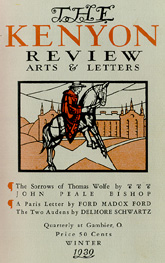To provide a general introduction to the early years of the Kenyon Review as well as a background for events
referred to in the letter excerpts, here follows a brief history of the first five years John Crowe Ransom relationship
with the Kenyon Review. The information contained herein was taken mainly from Marian Jansen's The Kenyon Review
1939-1970: A Critical History (Louisiana State University Press, Baton Rouge, 1989), particularly pages 10-17,
86-88, 93-94 and 99-103. Additional information taken from Joseph Blotner's Robert Penn Warren: A Biography (Random
House, New York, 1997)
The events that transpired to cause John Crowe Ransom to end his career at Vanderbilt and relocate to an obscure
college in an out of the way corner of the Midwest are still baffling in some ways. In this move, Vanderbilt lost
one of their star poets and professors, as well as several students who followed Ransom, and Kenyon College began
building what, throughout the 40's and 50's, was a hotbed of literary activity with few rivals. Ransom's move came
about through the initiative of Kenyon's newly elected president, Gordon Keith Chalmers, who, when he became president
in 1937, set himself to "improving the standards of scholarship"of the college. After Ransom's name was
suggested to Chalmers by their mutual friend Robert Frost, a correspondence ensued which resulted in Ransom's acceptance
of the offer Chalmers' offer on June 11, 1937.
At Vanderbilt, Ransom had been under pressure to complete his Ph.D. work, a prospect which did not interest him
in the least, and found himself anxious to distance himself from the Agrarian sentiment with which he had earlier
been aligned. At Kenyon, he received a higher salary and was afforded a lighter course load, allowing him time
which he hoped to use for getting back to some of his own poetry. An additional and unanticipated prospect came
shortly after Ransom began teaching his first semester of classes at Kenyon, when a proposal came to him from President
Chalmers. As Ransom related to his mother in a letter dated October 29, 1937, "the President called me to
talk about founding and editing a great Review here; that is more than I ever ventured to hope for." Thus
began the work which would finally come to fruition in 1939 with the first issue of The Kenyon Review, a
literary journal which quickly became one of the foremost of its kind.
|

|
In addition to being a frequent contributor to its pages, Robert Penn Warren's assistance as an editor were called
upon frequently during the first five years of the Review's existence. Two projects in particular stand
out in the early history of this longtime collaboration. Throughout much of the 30's Penn Warren, along with Cleanth
Brooks, both at the time professors at Louisiana State University, had been co-editors of the Southern Review,
a highly successful journal largely responsible for the increased visibility and respect of contemporary southern
authors. At then end of 1941, with opposition to the Southern Review from elsewhere within the University
coming to a head, Brooks and Warren were notified that the winter issue, soon to be published would be their last,
citing the necessity of funneling more state funding into the nation's war effort as the main reason.
This unfortunate turn of events turned out to finally be fortuitous for the Kenyon Review, who, not yet
into their fourth year of publication, had run into financial difficulties. Ransom immediately proposed a merger,
which would preserve the name and ideals of the Southern Review while at the same time boost the flagging
subscription rate of the Kenyon Review. One of the eventual effects of this merger was that the formidable
team of Brooks and Warren, who had been left free agents by the collapse of the Southern, were quickly signed
on as advisory editors for the Kenyon. This resulted in a fruitful period of collaboration, and in a couple
of impeccable, guest-edited issues, one by Brooks on the work of Gerard Manley Hopkins and one by Warren on Henry
James.
To commemorate the one hundredth anniversary of James' birthday, and coinciding with the end of the fifth year
of the Kenyon's publication, Robert Penn Warren took on the job of guest-editing a special issue devoted
to Henry James. The idea for this issue originally had occurred to Warren while he was still with the Southern
Review, showing that the Kenyon indeed had inherited much from the Southern. While Warren admitted
that he was certainly not an expert in James, he took over the correspondence regarding this special issue. While
the final list of contributors did not fully reflect Warren's initial tentative list, it was a still a long and
distinguished list. When the issue went to print, there were contributions from highly regarded authors such as
Austin Warren, K.A. Porter, F.O. Maththiessen, David Daiches, R.P. Blackmur, and Francis Fergusson. However, despite
certain disappointments that Warren faced in obtaining work from his list of hopefuls, the James issue was outstanding
and well diversified. This marked the end of the first five years of the publication of the Kenyon Review,
and one small chapter in the ongoing collaboration between John Crowe Ransom and Robert Penn Warren.